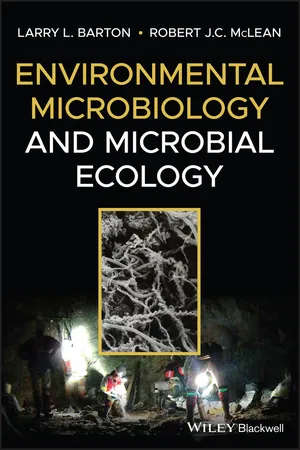
- English
- ePUB (mobile friendly)
- Available on iOS & Android
Environmental Microbiology and Microbial Ecology
About this book
An authoritative overview of the ecological activities of microbes in the biosphere
Environmental Microbiology and Microbial Ecology presents a broad overview of microbial activity and microbes' interactions with their environments and communities. Adopting an integrative approach, this text covers both conventional ecological issues as well as cross-disciplinary investigations that combine facets of microbiology, ecology, environmental science and engineering, molecular biology, and biochemistry. Focusing primarily on single-cell forms of prokaryotes — and cellular forms of algae, fungi, and protozoans — this book enables readers to gain insight into the fundamental methodologies for the characterization of microorganisms in the biosphere.
The authors draw from decades of experience to examine the environmental processes mediated by microorganisms and explore the interactions between microorganisms and higher life forms. Highly relevant to modern readers, this book examines topics including the ecology of microorganisms in engineered environments, microbial phylogeny and interactions, microbial processes in relation to environmental pollution, and many more.
Now in its second edition, this book features updated references and major revisions to chapters on assessing microbial communities, community relationships, and their global impact. New content such as effective public communication of research findings and advice on scientific article review equips readers with practical real-world skills.
- Explores the activities of microorganisms in specific environments with case studies and actual research data
- Highlights how prominent microbial biologists address significant microbial ecology issues
- Offers guidance on scientific communication, including scientific presentations and grant preparation
- Includes plentiful illustrations and examples of microbial interactions, community structures, and human-bacterial connections
- Provides chapter summaries, review questions, selected reading lists, a complete glossary, and critical thinking exercises
Environmental Microbiology and Microbial Ecology is an ideal textbook for graduate and advanced undergraduate courses in biology, microbiology, ecology, and environmental science, while also serving as a current and informative reference for microbiologists, cell and molecular biologists, ecologists, and environmental professionals.
Frequently asked questions
- Essential is ideal for learners and professionals who enjoy exploring a wide range of subjects. Access the Essential Library with 800,000+ trusted titles and best-sellers across business, personal growth, and the humanities. Includes unlimited reading time and Standard Read Aloud voice.
- Complete: Perfect for advanced learners and researchers needing full, unrestricted access. Unlock 1.4M+ books across hundreds of subjects, including academic and specialized titles. The Complete Plan also includes advanced features like Premium Read Aloud and Research Assistant.
Please note we cannot support devices running on iOS 13 and Android 7 or earlier. Learn more about using the app.
Information
1
Introduction to Microorganisms and Their Activities
1.1 Central Themes of Environmental Microbiology and Microbial Ecology
- Discussion on the continued use of the terms prokaryote and eukaryote and on the Tree of Life
- Horizontal gene transfer and the role of viruses and gene transfer agents
- Perspective of cell size and cell shape
- Bacterial production of dormant cells
1.2 Are the Terms Prokaryotes or Eukaryotes Relevant?
|
1.2.1 Intracellular Membranes in Prokaryotes
Table of contents
- Cover
- Table of Contents
- Preface
- 1 Introduction to Microorganisms and Their Activities
- 2 Microbes in the Biosphere
- 3 Terrestrial Systems
- 4 Aquatic Surface Environments
- 5 Life in Extreme Environments
- 6 Mutualism
- 7 Mutualism
- 8 Microbes Driving the Nutrient Cycles
- 9 Bioremediation Using Microorganisms
- 10 Biocorrosion and Geomicrobiology
- 11 Microbial Communities and Metabolic Networks
- Index
- End User License Agreement